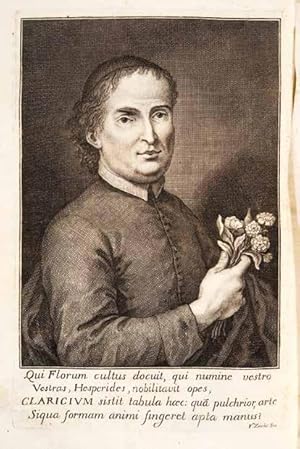clarici paolo bartolomeo description outstanding (1 Ergebnisse)
Produktart
- Alle Produktarten
- Bücher (1)
- Magazine & Zeitschriften
- Comics
- Noten
- Kunst, Grafik & Poster
- Fotografien
- Karten
-
Manuskripte &
Papierantiquitäten
Zustand
- Alle
- Neu
- Antiquarisch/Gebraucht
Einband
- alle Einbände
- Hardcover
- Softcover
Weitere Eigenschaften
- Erstausgabe
- Signiert
- Schutzumschlag
- Angebotsfoto
Land des Verkäufers
Verkäuferbewertung
-
Istoria e coltura delle piante che sono pe l fiore pi ragguardevoli, e pi distinte per ornare un giardino in tutto il tempo dell anno; con un copioso trattato degli agrumi. Opera postuma consacrata sua Eccelenza il Sig. Gerardo Sagredo.
Verlag: Venice, Andrea Poletti, 1726
Anbieter: Hünersdorff Rare Books ABA ILAB, London, Vereinigtes Königreich
Buch Erstausgabe
Soft cover. Zustand: Very Good. No Jacket. 1st Edition. 4to. [34] + 761 + [2] + [1 blank]p. Title in red and black. Engraved vignette on title-page signed FZ, portrait frontispiece of the author signed F. Zucchi; large engraved folding plan of the Villa Marocco and its garden (510 x 740mm) by Zucchi supplied in facsmile on old paper. Wood-engraved capitals, several large ornamental end-pieces (6 on otherwise blank pages). Original paste boards a la rustica . An important work for the documentation of flowers and the flower garden in the early 18th century. Clarici (1664-1725) was both scholar and practical horticulturist; his list of sources runs to 175 works, ranging from the classical authors to the most recent authorities, including botanists, pre-eminently, but also travellers, historians, architects, poets and writers on taste. Clarici s systematic work first provides an overall description of the garden and its site 10 miles from Venice. The book is then divided into four parts, the first covering the garden layout and responsibilities of the gardener; the second, the various skills required in cultivating plants in sections of the ornamental garden; the third, and major part (pp119- 152) subdivided into several chapters, describes individual plants (flowers, herbs, shrubs and spice trees) grouped according to their flower structure - there are numerous lists of contemporarily grown plants here with reference to their citation (if known) in earlier works. The fourth part is concerned with citrus fruits, and the cedar tree. The author's observations and notes are specially valuable in that he was up-to-date on the latest experiments in botanic and private gardens in Italy, and he knew well the day to day progress of the gardens round Padua where enthusiasm had been generated due to its famous botanic garden (founded in 1545) which continued to receive exotic plants from around the world for acclimatisation. Thus Clarici s work also provides a useful record of new species introduced; his perceptive knowledge additionally enabled him to clarify plants described by earlier authorities, such as Mattioli and Ferrari, with contemporarily listed ones, and establish the fact that many exotic species had existed in Europe long before they were assumed to have done so. It was through his contacts that Clarici had met his patron, Gerardo Sagrado, Procurator of St Mark s Cathedral, who had asked him to lay out his garden at Villa Marocco. The large engraved folding plan illustrates the layout, and is an example of Clarici s ideal. The book was posthunously published a year after its author s death by his nephew Domenico Clarici. A good copy, a few minor repairs. Pritzel 1728. Not in Hunt. See Georgina Masson, Italian Gardens, 1966, pp238-241, and Italian Flower Collectors Gardens in Seventeenth Century Italy in The Italian Garden (edited by David Coffin), Dumbarton Oaks, 1972, p64, where the above work is described as unexplored and invaluable for the wealth of information . about the flowers grown in Italy ; further that Clarici s book is remarkably scientific for the period, and his excellent bibliography a reminder of the fact that since the sixteenth century this world of flowers and gardens had been completely international . See also Lionel Puppi, The Villa Garden of the Veneto , in the same volume; and Claudia Lazzaro, The Italian Renaissance Garden, 1990.


